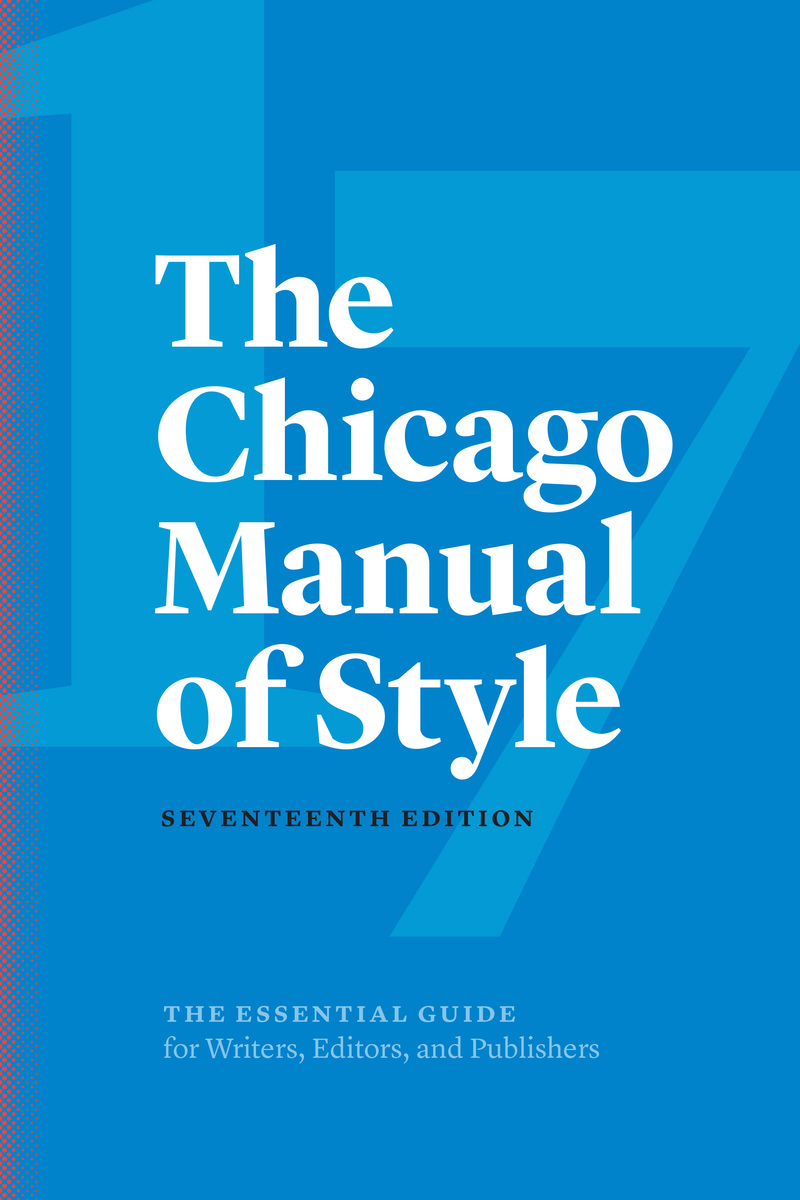Cloth: 978-0-226-28705-8
DOI: 10.7208/cmos17
AVAILABLE FROM
This title is no longer available from this publisher at this time. To let the publisher know you are interested in the title, please email bv-help@uchicago.edu.ABOUT THIS BOOK
In the seven years since the previous edition debuted, we have seen an extraordinary evolution in the way we create and share knowledge. This seventeenth edition of The Chicago Manual of Style has been prepared with an eye toward how we find, create, and cite information that readers are as likely to access from their pockets as from a bookshelf. It offers updated guidelines on electronic workflows and publication formats, tools for PDF annotation and citation management, web accessibility standards, and effective use of metadata, abstracts, and keywords. It recognizes the needs of those who are self-publishing or following open access or Creative Commons publishing models. The citation chapters reflect the ever-expanding universe of electronic sources—including social media posts and comments, private messages, and app content—and also offer updated guidelines on such issues as DOIs, time stamps, and e-book locators.
Other improvements are independent of technological change. The chapter on grammar and usage includes an expanded glossary of problematic words and phrases and a new section on syntax as well as updated guidance on gender-neutral pronouns and bias-free language. Key sections on punctuation and basic citation style have been reorganized and clarified. To facilitate navigation, headings and paragraph titles have been revised and clarified throughout. And the bibliography has been updated and expanded to include the latest and best resources available.
This edition continues to reflect expert insights gathered from Chicago’s own staff and from an advisory board of publishing experts from across the profession. It also includes suggestions inspired by emails, calls, and even tweets from readers. No matter how much the means of communication change, The Chicago Manual of Style remains the ultimate resource for those who care about getting the details right.
REVIEWS
TABLE OF CONTENTS
5. Grammar and Usage, by Bryan A. Garner
Preface
Acknowledgments
Part I · The Publishing Process
1. Books and Journals
The Parts of a Book
The Parts of a Journal
Considerations for Electronic Formats
2. Manuscript Preparation, Manuscript Editing, and Proofreading
Overview and Process Outline
Manuscript Preparation Guidelines for Authors
Manuscript Editing
Proofreading
3. Illustrations and Tables
Illustrations
Tables
4. Rights, Permissions, and Copyright Administration, by William S. Strong
Copyright Law and the Licensing of Rights
The Publishing Agreement
Subsidiary Rights and Permissions
The Author’s Responsibilities
Part II · Style and Usage
Grammar
Syntax
Word Usage
6. Punctuation
Punctuation in Relation to Surrounding Text
Periods
Commas
Semicolons
Colons
Question Marks
Exclamation Points
Hyphens and Dashes
Parentheses
Brackets and Braces
Slashes
Quotation Marks
Spaces
Multiple Punctuation Marks
Lists and Outline Style
7. Spelling, Distinctive Treatment of Words, and Compounds
Overview
Plurals
Possessives
“A” and “An”
Ligatures
Word Division
Italics, Capitals, and Quotation Marks
Compounds and Hyphenation
8. Names, Terms, and Titles of Works
Personal Names
Titles and Offices
Epithets, Kinship Names, and Personifications
Ethnic, Socioeconomic, and Other Groups
Names of Places
Words Derived from Proper Names
Names of Organizations
Historical and Cultural Terms
Calendar and Time Designations
Religious Names and Terms
Military Terms
Names of Ships and Other Vehicles
Scientific Terminology
Brand Names and Trademarks
Titles of Works
9. Numbers
Numerals versus Words
Plurals and Punctuation of Numbers
Inclusive Numbers
Roman Numerals
10. Abbreviations
Overview
Names and Titles
Geographical Terms
Designations of Time
Scholarly Abbreviations
Biblical Abbreviations
Technology and Science
Business and Commerce
11. Languages Other than English
General Principles
Languages Using the Latin Alphabet
Languages Usually Transliterated (or Romanized)
Classical Greek
Old English and Middle English
American Sign Language (ASL)
12. Mathematics in Type
Style of Mathematical Expressions
Preparation and Editing of Paper Manuscripts
13. Quotations and Dialogue
Overview
Permissible Changes to Quotations
Quotations in Relation to Text
Quotation Marks
Speech, Dialogue, and Conversation
Drama, Discussions and Interviews, and Field Notes
Ellipses
Interpolations and Clarifications
Attributing Quotations in Text
Part III · Source Citations and Indexes
14. Notes and Bibliography
Source Citations: An Overview
Basic Format, with Examples and Variations
Notes
Bibliographies
Author’s Name
Title of Work
Books
Periodicals
Websites, Blogs, and Social Media
Interviews and Personal Communications
Papers, Contracts, and Reports
Manuscript Collections
Special Types of References
Audiovisual Recordings and Other Multimedia
Legal and Public Documents
15. Author-Date References
Overview
Basic Format, with Examples and Variations
Reference Lists and Text Citations
Author-Date References: Special Cases
16. Indexes
Overview
Components of an Index
General Principles of Indexing
Indexing Proper Names and Variants
Indexing Titles of Publications and Other Works
Alphabetizing
Punctuating Indexes: A Summary
The Mechanics of Indexing
Editing an Index Compiled by Someone Else
Typographical Considerations for Indexes
Examples of Indexes
Glossary
Bibliography
Index
